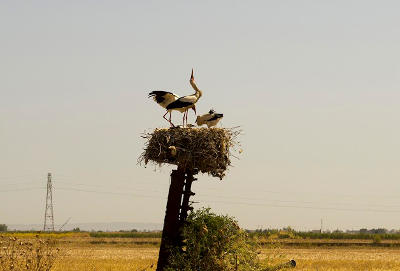Using AI to control energy for indoor agriculture
30 September 2024
Published online 27 January 2016
Trade-offs may shape the migratory decisions of white storks.

© Andrea Flack
Researchers at Germany’s Max Planck Institute for Ornithology worked with colleagues in Spain, Russia, Armenia, Greece, Poland, Tunisia, Israel and South Africa to collect data from eight white stork populations in Europe and North Africa. Using GPS together with acceleration sensors, they tracked the position and movement of young storks to identify patterns.
While the sensors sent back low-resolution tracking data, the team could only collect the high-resolution data stored on the sensor by downloading it from nearby or by recovering the sensor. Many storks die en route, and since their migration carries them through countries that have become unsafe, data recovery proved a major challenge. “We have plenty of tags lying around which we would love to get data from, but we couldn’t get them ourselves or find anyone to go,” says Andrea Flack of Max Planck, who led the study.
The team, however, collected enough data to identify distinct patterns. The storks of each population flew a characteristic distance and followed a route that, Flack suspects, they use each year. In addition, the populations seem to follow different migration strategies.
The Armenian storks and some of the German storks migrated only a short distance, overwintering north of the Sahara. The remaining German storks and those from most of the other populations migrated over the Sahara to overwinter in the south, reaching as far as South Africa. Despite flying more than three times as far as the storks overwintering in the north, these birds used only 30% more energy during their migration, possibly because they could take advantage of thermal updrafts to ease their flight across the desert.
A third surprising finding came from the storks of the Uzbekistan population, which didn’t migrate at all. “We expected them to go east towards India or China based on their history, and I hope we can work on this and find out why they didn’t migrate,” says Flack.
While the storks which crossed the Sahara may have had an easier time during migration, the study identified a trade-off once they reached their destination. The short-distance migrants endured a demanding flight but overwintered in areas with a higher human population density, yielding easily available food in garbage dumps and landfills. The long-distance migrants, on the other hand, spent the winter in areas without many humans and so had to use more energy foraging.
“Logistically, this was a fantastic operation and I believe it’s the first time that we’ve gotten such high quality data that are truly comparable. It’s remarkable that there’s so much variation in the migration strategies,” says Arie van Noordwijk of the Netherlands Institute of Ecology, who was not involved in the study.
The different payoffs of these strategies may lead to changes in the storks’ migration, which would also have an impact at their destination. “The storks feed on insects that turn into pests, like locusts and armyworms,” Flack offers as an example.
As these flexible birds adjust to a changing world, so too must the ecosystems that have adapted to their annual visits, say the scientists.
doi:10.1038/nmiddleeast.2016.6
Stay connected: